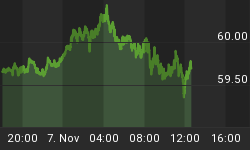Our indicator constructed from the trends in the CRB Index, gold, and yields on the 10 year Treasury has come off of the extreme readings seen several weeks ago, and within the context of a trend following strategy that I have detailed here, here, and here, this represents a buy signal for the SP500. In essence, with prices on the SP500 above its 40 week moving average and our indicator not in the extreme zone, prices should move higher. In other words, this is a good time to be "buying the dip"; however, this strategy is not without risks.
The indicator constructed from the trends in the CRB Index, gold, and yields on the 10 year Treasury is shown in the middle of a weekly chart of the SP500 in figure 1. In addition, I have placed a RSI indicator in the lower panel; this is indicator has a 3 week look back period. The RSI indicator is currently oversold to an extreme degree, and in a "great" place to "buy the dip". Or so we would like to think.
Figure 1. SP500/ weekly
So let's do exactly that and construct a strategy where we "buy the dip" on the SP500 when these 3 conditions are met: 1) the SP500> 40 week moving average; 2) the composite indicator is not extreme; 3) 3 period RSI is extreme. We will look at data going back to 1992 and our holding period (for the sake of making our point) is only 4 weeks. Slippage and commissions are not considered.
This strategy produced 46 trades and 76% were profitable. So far "buying the dip" looks really good. However, if we look the maximum adverse excursion (MAE) for this strategy, we note that a high number of trades had significant draw downs. If you remember, the MAE graph (see figure 2) looks at every trade from a strategy, and MAE measures how much a trade goes against its entry price before being closed out for a winner or loser. MAE is the angst factor. Looking at the MAE graph, note the trade inside the blue box. This trade had an MAE or draw down of 6.06% (x axis) before being closed out for a 1.4% (y axis) winner. We know this trade was a winner because it is a green caret.
Figure 2. MAE Graph
As stated above, "buying the dip" is fraught with consequences. In this case, 10 out 46 trades (22%) had draw downs greater than 5% over a 4 week period. These would be the trades to the right of the blue line. The majority of the trades had MAE's less than 2% suggesting that "buying the dip" was a good idea under these conditions.
The bottom line: trends in the CRB Index, gold, and yields on the 10 year Treasury are weakening and falling, and with prices on the SP500 above their 40 week moving average, this headwind has been removed. "Buying the dip" is a satisfactory strategy, but one that is fraught with consequences. From this data, I believe a reduced allocation to equities is worthwhile.
















